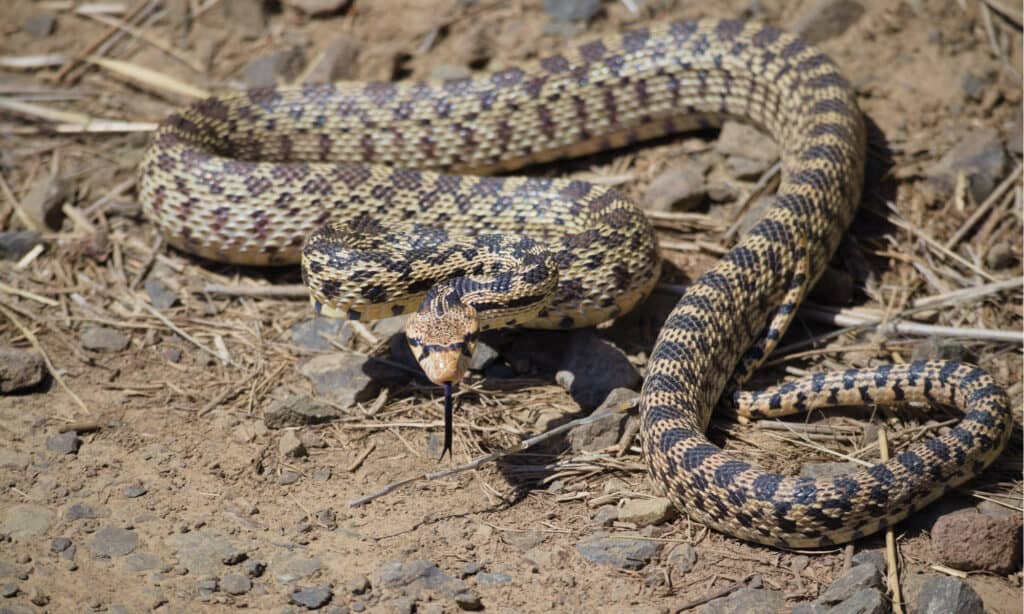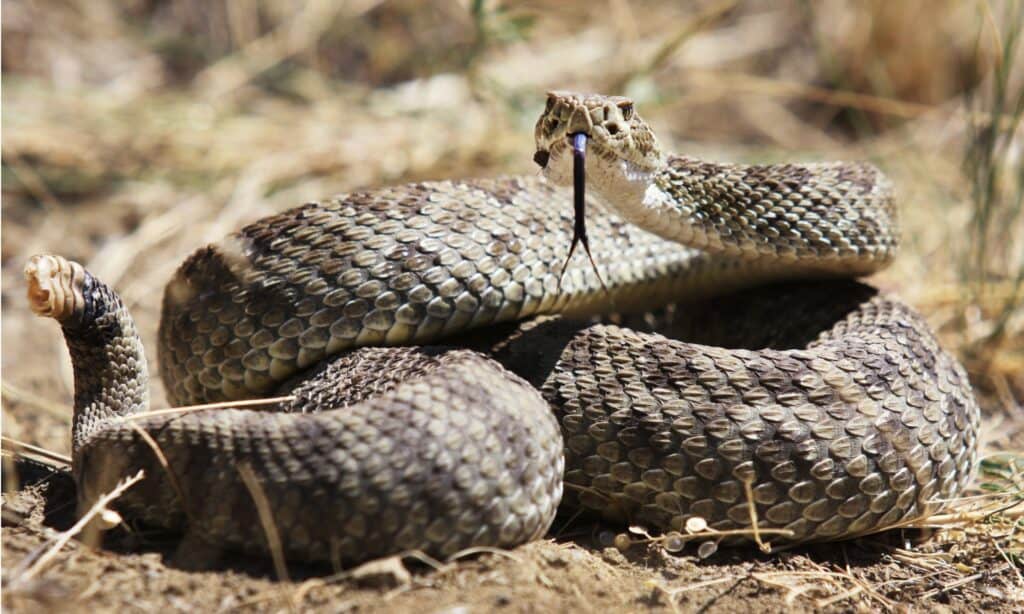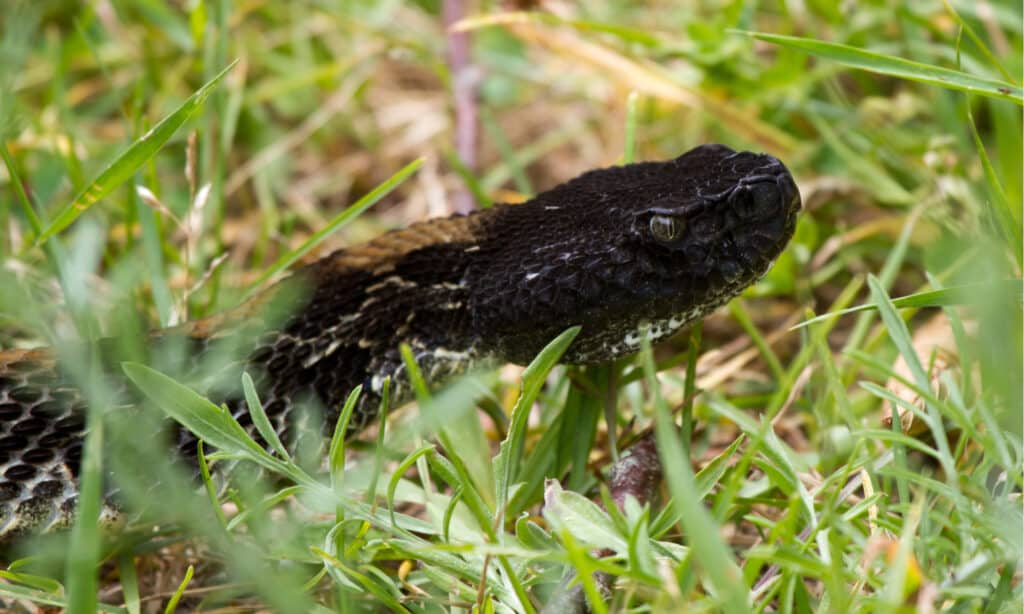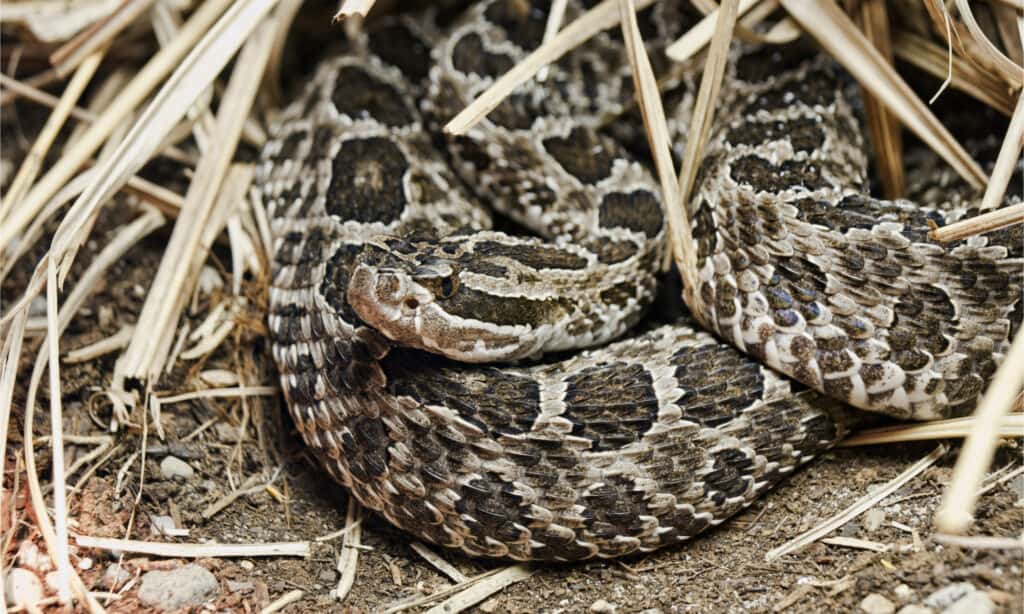The Midwest has a lot of wildlife, but most people don’t know that snakes are a diverse part of the region! There are all sorts of different snake species that can be found across the Midwest, venomous and nonvenomous alike. Today, we are going to explore some of the most common Midwestern snakes and learn a bit about them. Let’s discover 10 Midwest snakes!
A list of the most common snakes in the Midwest
Garter snakes

The common and plains garter snakes are the most common species in the Midwest.
©iStock.com/Wildnerdpix
Garter snakes are some of the most common snakes across the entire country, including the Midwest. There are around 35 different species of garter snake, all with their own distinct ranges and habitat preferences. In the Midwest, the most common species of garter snakes are the common garter snake and the plains garter snake. These little snakes may be common, but they aren’t dangerous to humans at all and are nonvenomous.
The best way to identify a garter snake is by its pattern. Garter snakes have a base color, usually gray or brown, and three vertical stripes that run from their head to their tail. Two of the stripes are along the sides of the snake, while the third is along its spine. These stripes are usually white or yellow.
Kingsnakes

The prairie kingsnake is the most common kingsnake in the Midwest.
©Matt Jeppson/Shutterstock.com
Kingsnakes, like garter snakes, aren’t a single species of snake. There are 26 species of kingsnake and over 45 subspecies. These snakes get their names from their habit of eating other snakes, especially venomous ones. They have a natural immunity to many types of venom, allowing them to feed on rattlesnakes, copperheads, and more. Despite regularly eating dangerous snakes, kingsnakes aren’t dangerous to humans and are non venomous. The most common species of kingsnake in the Midwest is the prairie kingsnake.
The prairie kingsnake is tan, brown, or gray and has irregular splotches down its body. These splotches are usually brown and ringed in black. Additionally, their heads usually have a backward V pattern in the same color as the splotches, with the two points of the V ending near their eyes.
Smooth green snake

Smooth green snakes are also known as grass snakes.
©iStock.com/tamers1
The smooth green snake is an extremely common snake that lives all over the United States. They are small and thin and are sometimes called grass snakes. Green snakes are divided into three subspecies, with the western green snake being the most common one across the Midwest. The green snake is a nonvenomous snake and isn’t dangerous to humans.
There are few snakes that look like the smooth green snake in the Midwest. They are small, thin, and come in a bright shade of green.
Water snakes

There are many species of water snakes that can be found across the United States, many of which can be found in the Midwest. As their name suggests, these snakes are generally aquatic or semi-aquatic, preferring rivers, lakes, and marshlands. The most common water snakes in the Midwest are the common water snake (both subspecies) and the plain-bellied watersnake. All water snakes are nonvenomous, despite their resemblance to the venomous water moccasin.
Each species of water snake has its own coloration and pattern. Common water snakes are usually brown or brownish-gray and have irregular banding (usually brown) down their back. The plain-bellied watersnake is usually light gray or black and has a yellowish or cream belly.
Bullsnake

Bullsnakes are a subspecies of the gopher snake and live in the Great Plains region of the US.
©Christopher Joe Brown/Shutterstock.com
The bullsnake is a subspecies of the gopher snake and can be found across much of the Midwest. They can grow quite large (sometimes up to 8 feet) and inhabit the Great Plains region. They are occasionally mistaken for rattlesnakes since they shake their tail as a mimicry defense, but bullsnakes are nonvenomous.
Bullsnakes are usually light brown or tan and have dark splotches down their backs. The splotches are usually darkest near the head and tail and light in the middle of their bodies.
Great plains rat snake

Great Plains rat snakes are non-venomous with a timid nature.
©Matt Jeppson/Shutterstock.com
Rat snakes are among the most commonly seen snakes in the United States. There are a few species of rat snake, with the Great Plains rat snake being the most common across the Midwest. Rat snakes get their name for their habit of preying on small mammals, especially mice and rats. They are harmless and nonvenomous.
The Great Plains rat snake has a gray or light tan base color with squarish brown splotches down its back. Smaller splotches can also be seen along the sides of the snake, heading down towards its tail. These snakes look quite similar to the gray rat snake.
Prairie rattlesnake

The prairie rattlesnake is a venomous rattlesnake that lives across the Great Plains region.
©iStock.com/HRossD
The prairie rattlesnake is the first venomous snake on our list. This is a dangerous rattlesnake that lives across the Great Plains region of the Midwest and into Canada. Rattlesnakes are known for their distinct tail rattle, which is used as a warning sign to any potential predators. As members of the pit viper family, prairie rattlesnakes are venomous and dangerous to humans.
The prairie rattlesnake has a light brown body with circular patches of dark brown on its back. Additionally, prairie rattlesnakes have triangular heads and heat-sensing pits near their noses.
Copperhead

Copperheads mostly live in the eastern US, but their range extends into some Midwestern states.
©iStock.com/David Kenny
The copperhead is an extremely common snake across the eastern United States, although part of its range extends into some Midwestern states. These snakes are pit vipers, making them related to rattlesnakes and cottonmouths. The copperhead is responsible for the most bites of any venomous snakes in the US, although it has the weakest venom of any of the pit vipers.
Copperheads are copper colored, although some individuals can be more reddish, pink, or gray in their shading. Their eyes are usually golden and they have heat-sensing pits between their eyes and nose, allowing them to track prey.
Timber rattlesnake

Timber rattlesnakes are wide-ranging snakes that can be found across much of the Midwest.
©Frode Jacobsen/Shutterstock.com
The timber rattlesnake is a member of the rattlesnake family and a pit viper. These rattlesnakes get their name from their tendency to live in forests. They go by many names, including the canebrake and banded rattlesnake. They are tied with the prairie rattlesnake as the most northerly distributed venomous snake in the United States.
The timber rattlesnake often has a dark black head, although some individuals have a yellow, brown, or tan head. Additionally, it has a chevron banding pattern down its back, plus the distinctive rattle.
Massasauga rattlesnake

Two subspecies of the Massasauga rattlesnake can be found in the Midwest.
©DnDavis/Shutterstock.com
The Massasauga rattlesnake is a common rattlesnake across the Midwest whose name means “great river mouth”. It belongs to the pit viper and rattlesnake family and is quite dangerous and venomous. There are three subspecies of Massasauga, with the eastern and western Massasauga being present in the Midwest.
Massasauga rattlesnakes are thick snakes with a light gray or tan base color and rows of dark, rounded spots down their back. These spots are pretty numerous and cover most of the available surface area of the snake. Aside from patterning, these snakes also have rattles and heat-sensing pits.
The photo featured at the top of this post is © DnDavis/Shutterstock.com
Discover the "Monster" Snake 5X Bigger than an Anaconda
Every day A-Z Animals sends out some of the most incredible facts in the world from our free newsletter. Want to discover the 10 most beautiful snakes in the world, a "snake island" where you're never more than 3 feet from danger, or a "monster" snake 5X larger than an anaconda? Then sign up right now and you'll start receiving our daily newsletter absolutely free.
Thank you for reading! Have some feedback for us? Contact the AZ Animals editorial team.






